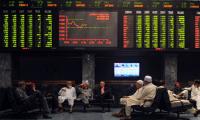KARACHI: Pakistan's current account balance turned negative in January, as a surge in imports outweighed a modest increase in remittances and a slight decline in exports, central bank data showed on Monday.
The current account shortfall was $269 million, compared with a surplus of $404 million in December, the State Bank of Pakistan data showed. The deficit was also higher than the $167 million recorded in the same month a year earlier.
The SBP's broad strategy, which directs banks to manage imports by funding the letters of credit with their own liquidity, appears to have maintained stability in the external account. The banks tried to strike a balance between inflows and outflows connected to imports and exports, according to analysts. Furthermore, the combination of record-high interest rates and stubborn inflation with slow economic growth had already reduced demand.
Consequently, the overall current account deficit continued to be under control. In the first seven months of the fiscal year 2023–2024, the nation's current account deficit dropped to $1.1 billion, a 71 percent decrease from the same period last year.
However, because of an imbalance in the trade gap, the country recorded a current account deficit in January. The Pakistan Bureau of Statistics reported that the trade deficit increased to $1.97 billion in January, a month-on-month increase of 8.26 percent. The SBP statistics revealed that overall imports reached $4.511 billion in January, up 10 percent from the previous month. In contrast, exports decreased by 4 percent to $2.693 billion. Remittances rose by 1 percent to $2.397 billion.
“This increase [in imports] was driven by the need for urea imports amidst shortages in the local market and higher LNG imports in response to increased demand during the winter season,” said Maaz Azam, an analyst at Optimus Capital Management.
“Additionally, the food sector experienced an uptick, primarily attributable to a 24 percent month-on-month increase in palm oil imports and a 47 percent month-on-month surge in imports of other food items,” Azam added.
The SBP projected that the current account deficit would be between 0.5 and 1.5 percent of GDP in FY24. The State Bank of Pakistan reported net foreign reserves of $8 billion as of 9 February 2024, up from a low of $2.9 billion on 3 February 2023, indicating that Pakistan's external situation has improved recently. For the current fiscal year, according to the SBP, $24.5 billion in external financing is needed overall. Out of this, the majority has been repaid or rolled over.
The picture shows a logo of Federation of Pakistan Chambers of Commerce & Industry . — APP/FileKARACHI: Atif Ikram...
The image shows the logo of the Securities and Exchange Commission of Pakistan . — APP/FileISLAMABAD: The Securities...
This image released on January 26, 2023, shows the logo of Archroma. — Facebook/ArchromaKARACHI: Archroma Pakistan...
The logo of the Trade Development Authority of Pakistan . — TDAP website. Mirpur: Kausar Taqadus Gilani, Minister...
This representational image shows Gold bars. — AFP/FileKARACHI: Gold prices in the local market dropped by Rs600 per...
Security personnel walk past the US Federal Reserve building in Washington, DC on Oct 22, 2021. —...







